目录
一、初始MQ
1.1、同步调用
之前说过,我们现在基于OpenFeign的调用都属于是同步调用,那么这种方式存在哪些问题呢?举个例子,我们以余额支付功能为例来分析,首先看下整个流程:

目前我们采用的是基于OpenFeign的同步调用,也就是说业务执行流程是这样的:
-
支付服务需要先调用用户服务完成余额扣减
-
然后支付服务自己要更新支付流水单的状态
-
然后支付服务调用交易服务,更新业务订单状态为已支付
三个步骤依次执行。
这其中就存在3个问题:
第一,拓展性差
我们目前的业务相对简单,但是随着业务规模扩大,产品的功能也在不断完善。在大多数电商业务中,用户支付成功后都会以短信或者其它方式通知用户,告知支付成功。假如后期产品经理提出这样新的需求,你怎么办?是不是要在上述业务中再加入通知用户的业务?某些电商项目中,还会有积分或金币的概念。假如产品经理提出需求,用户支付成功后,给用户以积分奖励或者返还金币,你怎么办?是不是要在上述业务中再加入积分业务、返还金币业务?。。。最终你的支付业务会越来越臃肿:
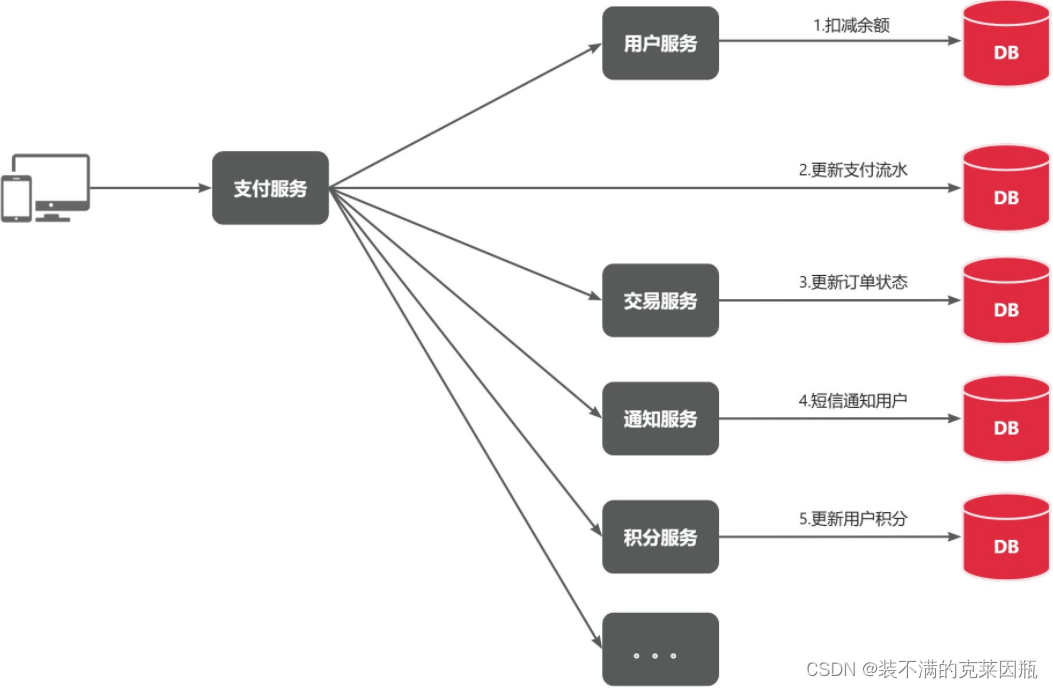
也就是说每次有新的需求,现有支付逻辑都要跟着变化,代码经常变动,不符合开闭原则,拓展性不好。
第二,性能下降
由于我们采用了同步调用,调用者需要等待服务提供者执行完返回结果后,才能继续向下执行,也就是说每次远程调用,调用者都是阻塞等待状态。最终整个业务的响应时长就是每次远程调用的执行时长之和:

假如每个微服务的执行时长都是50ms,则最终整个业务的耗时可能高达300ms,性能太差了。
第三,级联失败
由于我们是基于OpenFeign调用交易服务、通知服务。当交易服务、通知服务出现故障时,整个事务都会回滚,交易失败。这其实就是同步调用的级联失败问题。
但是大家思考一下,我们假设用户余额充足,扣款已经成功,此时我们应该确保支付流水单更新为已支付,确保交易成功。毕竟收到手里的钱没道理再退回去吧。
因此,这里不能因为短信通知、更新订单状态失败而回滚整个事务。
综上,同步调用的方式存在下列问题:
-
拓展性差
-
性能下降
-
级联失败
而要解决这些问题,我们就必须用异步调用的方式来代替同步调用。
1.2、异步调用
异步调用方式其实就是基于消息通知的方式,一般包含三个角色:
-
消息发送者:投递消息的人,就是原来的调用方
-
消息Broker:管理、暂存、转发消息,你可以把它理解成微信服务器
-
消息接收者:接收和处理消息的人,就是原来的服务提供方

在异步调用中,发送者不再直接同步调用接收者的业务接口,而是发送一条消息投递给消息Broker。然后接收者根据自己的需求从消息Broker那里订阅消息。每当发送方发送消息后,接受者都能获取消息并处理。这样,发送消息的人和接收消息的人就完全解耦了。
还是以余额支付业务为例:
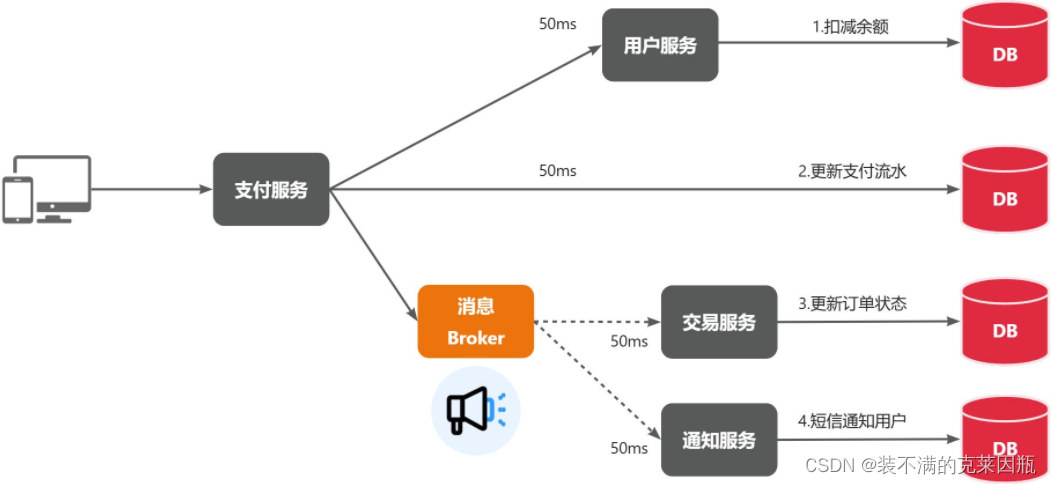
除了扣减余额、更新支付流水单状态以外,其它调用逻辑全部取消。而是改为发送一条消息到Broker。而相关的微服务都可以订阅消息通知,一旦消息到达Broker,则会分发给每一个订阅了的微服务,处理各自的业务。
假如产品经理提出了新的需求,比如要在支付成功后更新用户积分。支付代码完全不用变更,而仅仅是让积分服务也订阅消息即可:

不管后期增加了多少消息订阅者,作为支付服务来讲,执行问扣减余额、更新支付流水状态后,发送消息即可。业务耗时仅仅是这三部分业务耗时,仅仅100ms,大大提高了业务性能。
另外,不管是交易服务、通知服务,还是积分服务,他们的业务与支付关联度低。现在采用了异步调用,解除了耦合,他们即便执行过程中出现了故障,也不会影响到支付服务。
综上,异步调用的优势包括:
-
耦合度更低(解耦)
-
性能更好(异步)
-
业务拓展性强
-
故障隔离,避免级联失败
当然,异步通信也并非完美无缺,它存在下列缺点:
-
完全依赖于Broker的可靠性、安全性和性能
-
架构复杂,后期维护和调试麻烦
1.3、MQ技术选型
消息Broker,目前常见的实现方案就是消息队列(MessageQueue),简称为MQ.目比较常见的MQ实现:
-
ActiveMQ
-
RabbitMQ
-
RocketMQ
-
Kafka
几种常见MQ的对比:
| RABBITMQ | ACTIVEMQ | ROCKETMQ | KAFKA | |
|---|---|---|---|---|
| 公司/社区 | Rabbit | Apache | 阿里 | Apache |
| 开发语言 | Erlang | Java | Java | Scala&Java |
| 协议支持 | AMQP,XMPP,SMTP,STOMP | OpenWire,STOMP,REST,XMPP,AMQP | 自定义协议 | 自定义协议 |
| 可用性 | 高 | 一般 | 高 | 高 |
| 单机吞吐量 | 一般 | 差 | 高 | 非常高 |
| 消息延迟 | 微秒级 | 毫秒级 | 毫秒级 | 毫秒以内 |
| 消息可靠性 | 高 | 一般 | 高 | 一般 |
追求可用性:Kafka、 RocketMQ 、RabbitMQ
追求可靠性:RabbitMQ、RocketMQ
追求吞吐能力:RocketMQ、Kafka
追求消息低延迟:RabbitMQ、Kafka
据统计,目前国内消息队列使用最多的还是RabbitMQ,再加上其各方面都比较均衡,稳定性也好。
二、RabbitMQ
RabbitMQ是基于Erlang语言开发的开源消息通信中间件,官网地址:Messaging that just works — RabbitMQ接下来,我们就学习它的基本概念和基础用法。
2.1、安装
我们这里基于Docker来安装RabbitMQ。
先将资料中的mq.tar传到你的Linux虚拟机中,我这里就放在/root目录下。

切换到/root的目录下,进行加载此镜像:
docker load -i mq.tar然后直接运行容器:
docker run \
-e RABBITMQ_DEFAULT_USER=itheima \
-e RABBITMQ_DEFAULT_PASS=123321 \
-v mq-plugins:/plugins \
--name mq \
--hostname mq \
-p 15672:15672 \
-p 5672:5672 \
--network hmall \
-d \
rabbitmq:3.8-management注意:这里面的 --network hmall代表连接我们的自定义网络hmall,其实是结合我的另一篇文章进行连接的,但为了方便小伙伴们,这里我们在执行docker run前先执行一条命令:
# 1.首先通过命令创建一个网络
docker network create hmall执行完,再执行docker run的命令。
然后使用docker ps查询下:

发现运行容器成功。
可以看到在安装命令中有两个映射的端口:
-
15672:RabbitMQ提供的管理控制台的端口
-
5672:RabbitMQ的消息发送处理接口
安装完成后,我们访问 http://192.168.150.101:15672即可看到管理控制台。首次访问需要登录,默认的用户名和密码在配置文件中已经指定了。登录后即可看到管理控制台总览页面:
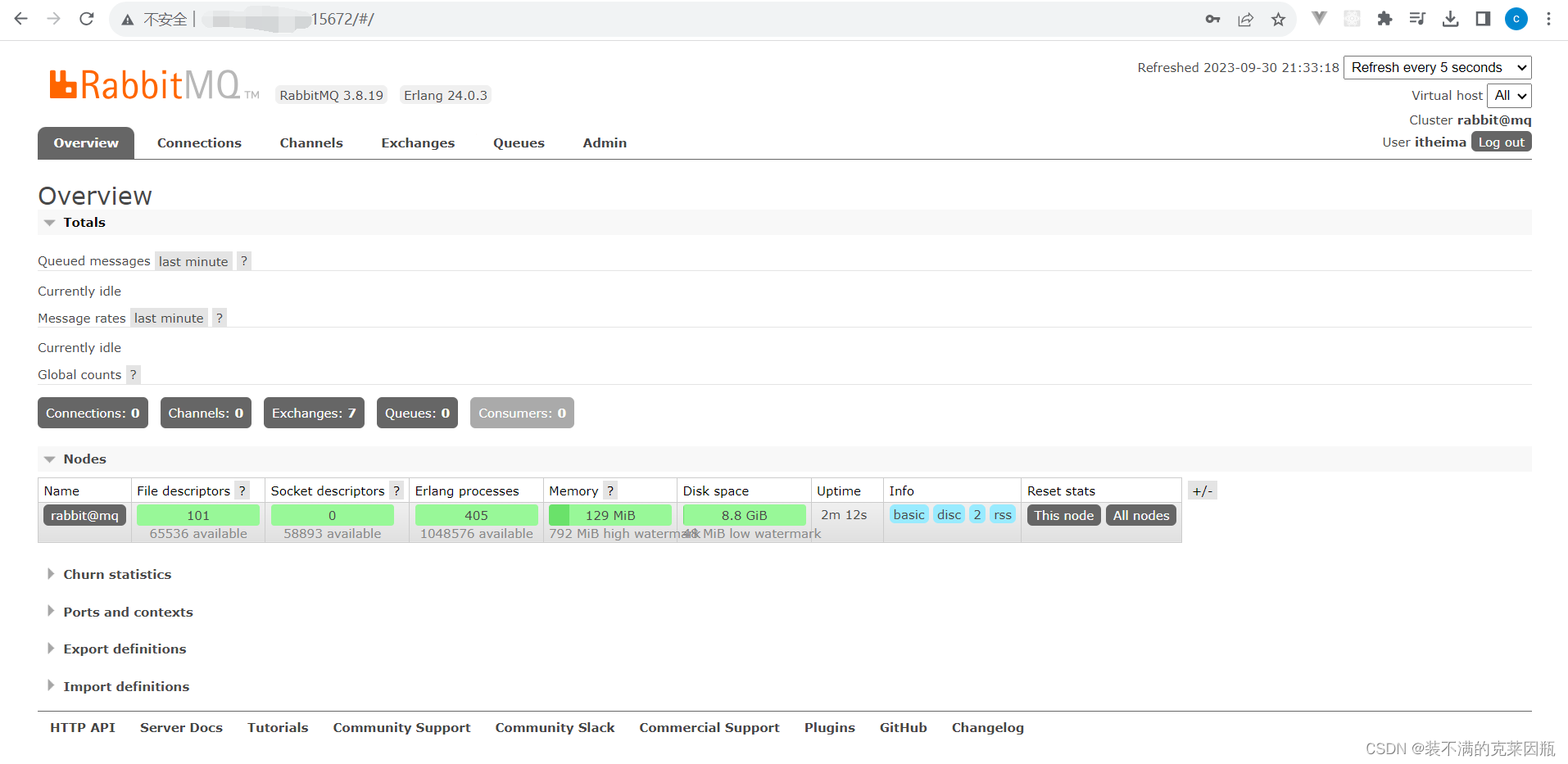
RabbitMQ对应的架构如图:
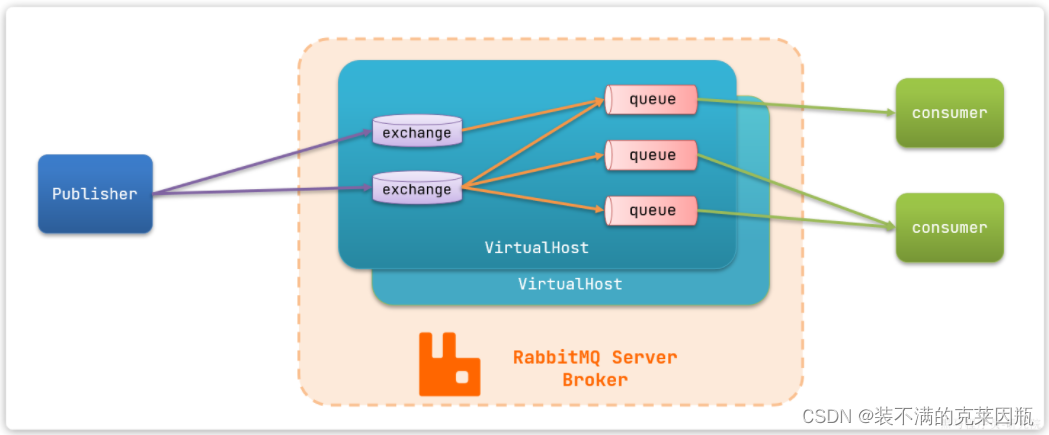
其中包含几个概念:
-
publisher:生产者,也就是发送消息的一方 -
consumer:消费者,也就是消费消息的一方 -
queue:队列,存储消息。生产者投递的消息会暂存在消息队列中,等待消费者处理 -
exchange:交换机,负责消息路由。生产者发送的消息由交换机决定投递到哪个队列。 -
virtual host:虚拟主机,起到数据隔离的作用。每个虚拟主机相互独立,有各自的exchange、queue
上述这些东西都可以在RabbitMQ的管理控制台来管理,下一节我们就一起来学习控制台的使用。
2.2、收发消息
2.2.1、交换机
我们打开Exchanges选项卡,可以看到已经存在很多交换机
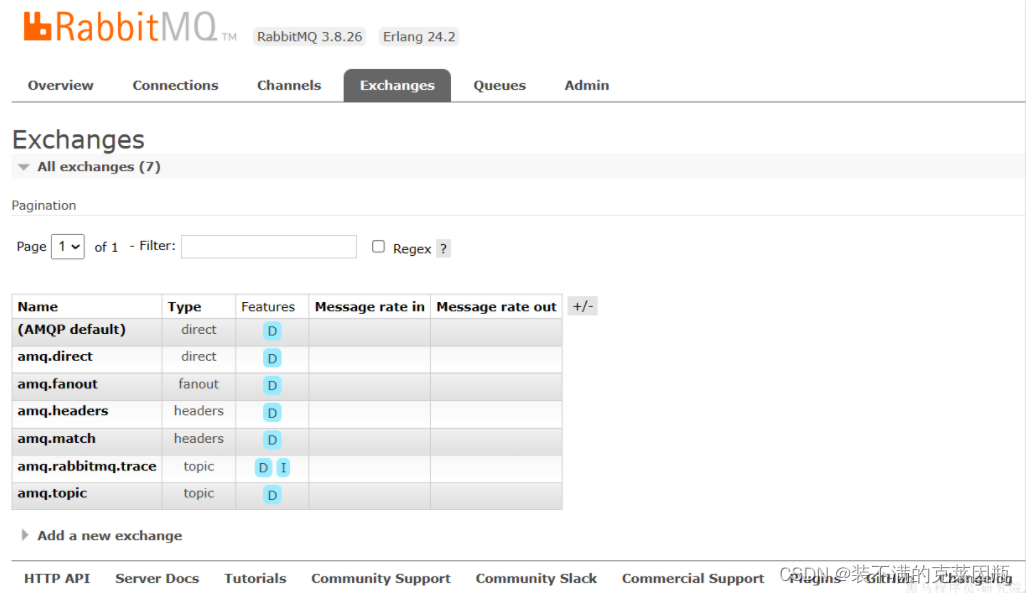
我们点击任意交换机,即可进入交换机详情页面。仍然会利用控制台中的publish message 发送一条消息:
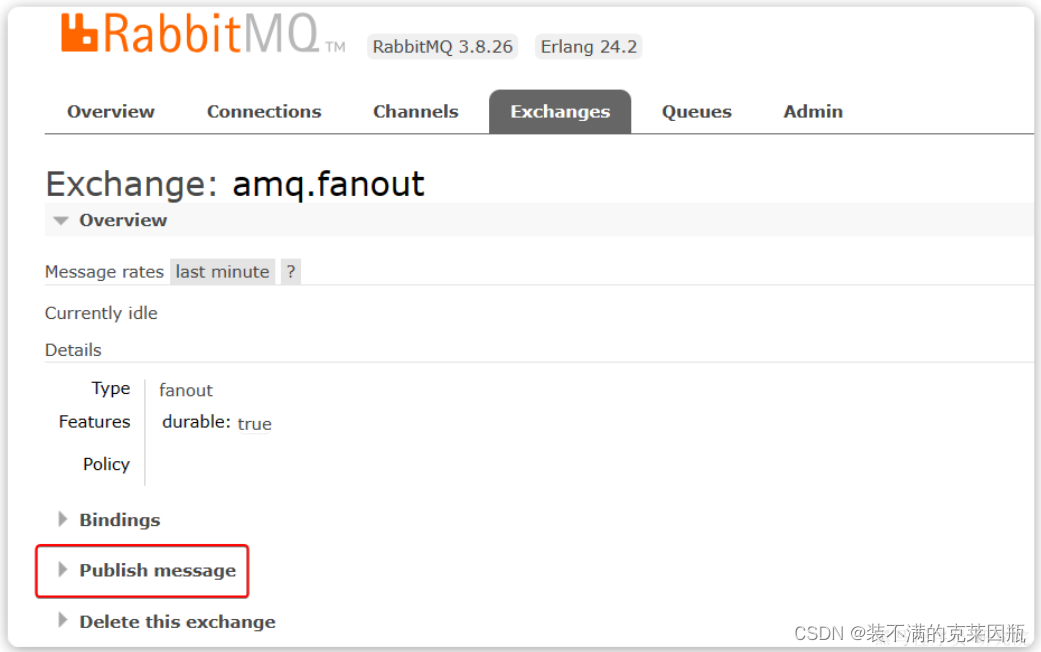

这里是由控制台模拟了生产者发送的消息。由于没有消费者存在,最终消息丢失了,这样说明交换机没有存储消息的能力。
2.2.2、队列
我们打开Queues选项卡,新建一个队列:

命名为hello.queue1:

再以相同的方式,创建一个队列,密码为hello.queue2,最终队列列表如下:

此时,我们再次向amq.fanout交换机发送一条消息。会发现消息依然没有到达队列!!怎么回事呢?发送到交换机的消息,只会路由到与其绑定的队列,因此仅仅创建队列是不够的,我们还需要将其与交换机绑定。
2.2.3、绑定关系
点击Exchanges选项卡,点击amq.fanout交换机,进入交换机详情页,然后点击Bindings菜单,在表单中填写要绑定的队列名称:
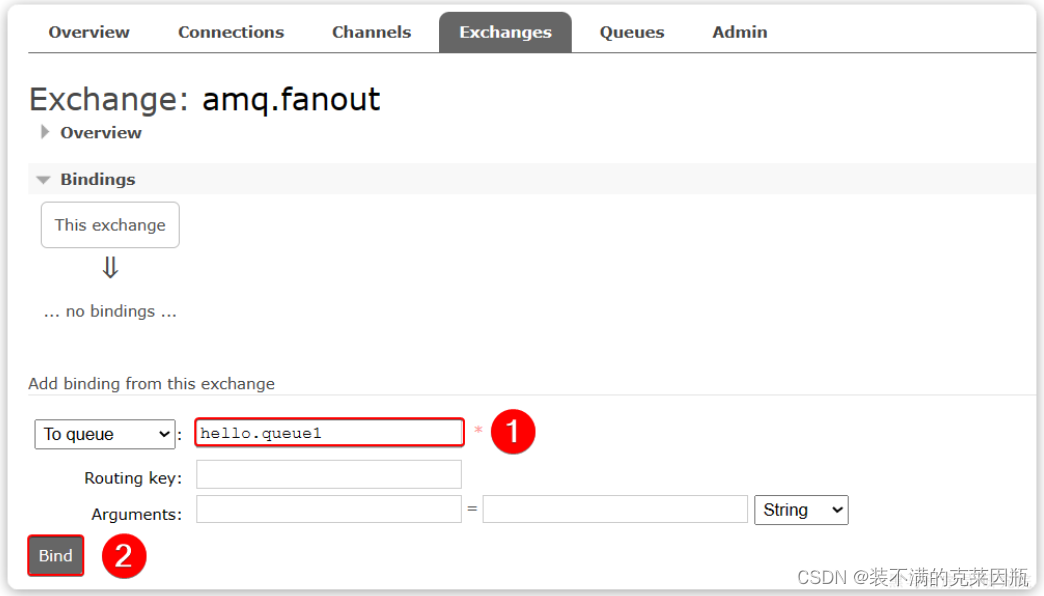
相同的方式,将hello.queue2也绑定到改交换机。
最终,绑定结果如下:
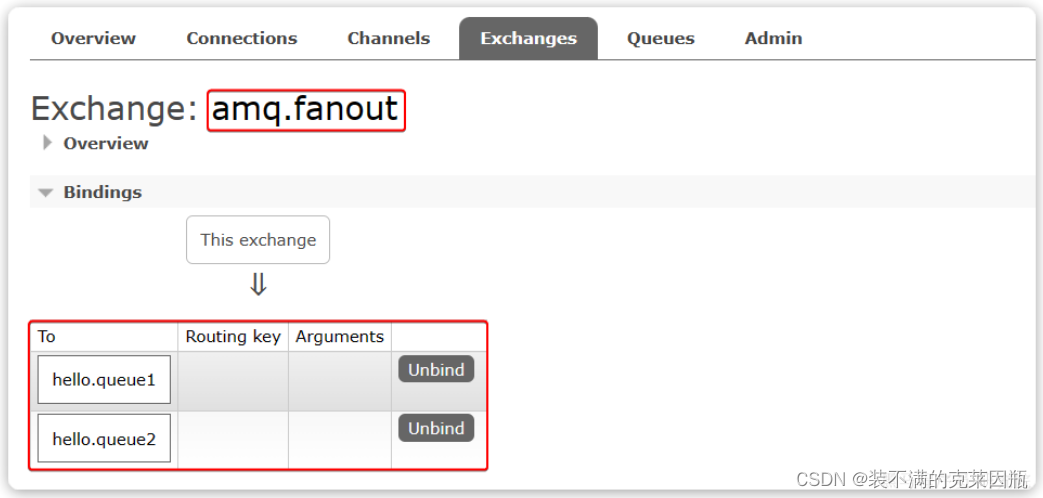
2.2.4、发送消息
再次回到exchange页面,找到刚刚绑定的amq.fanout,点击进入详情页,再次发送一条消息:
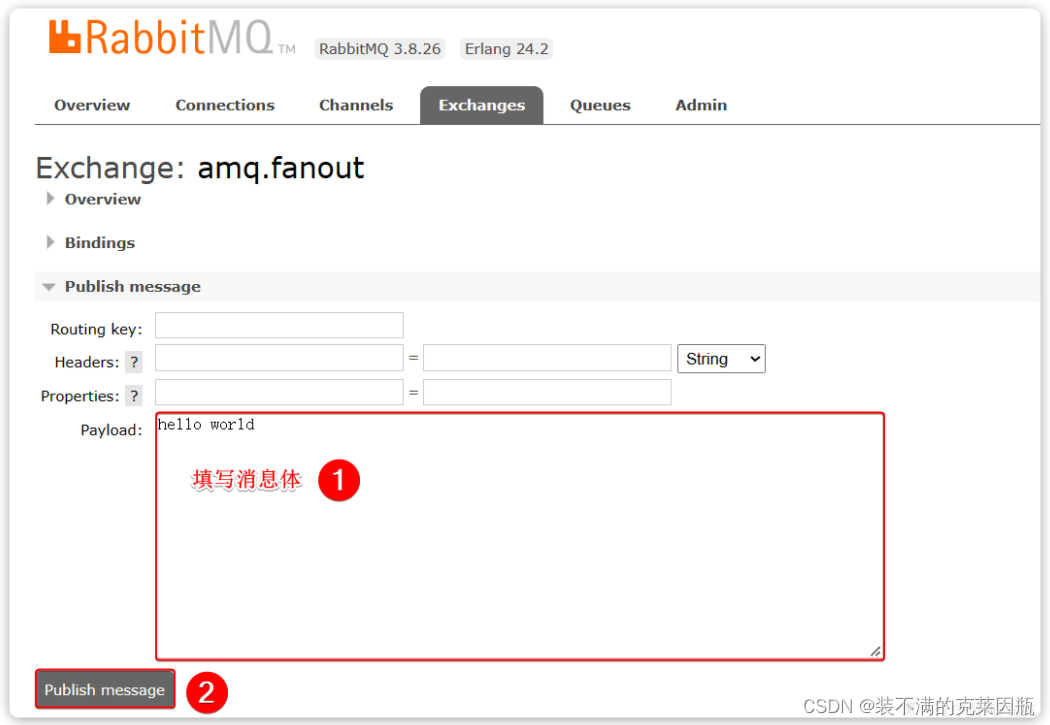
回到Queues页面,可以发现hello.queue中已经有一条消息了:
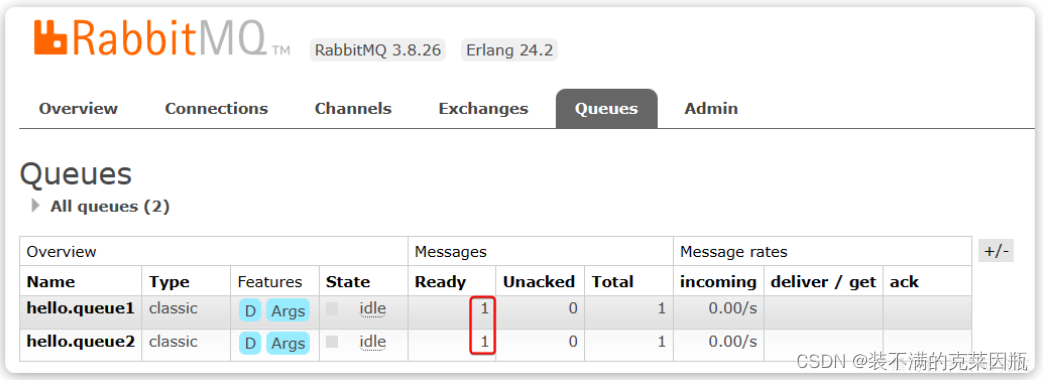
点击队列名称,进入详情页,查看队列详情,这次我们点击get message:
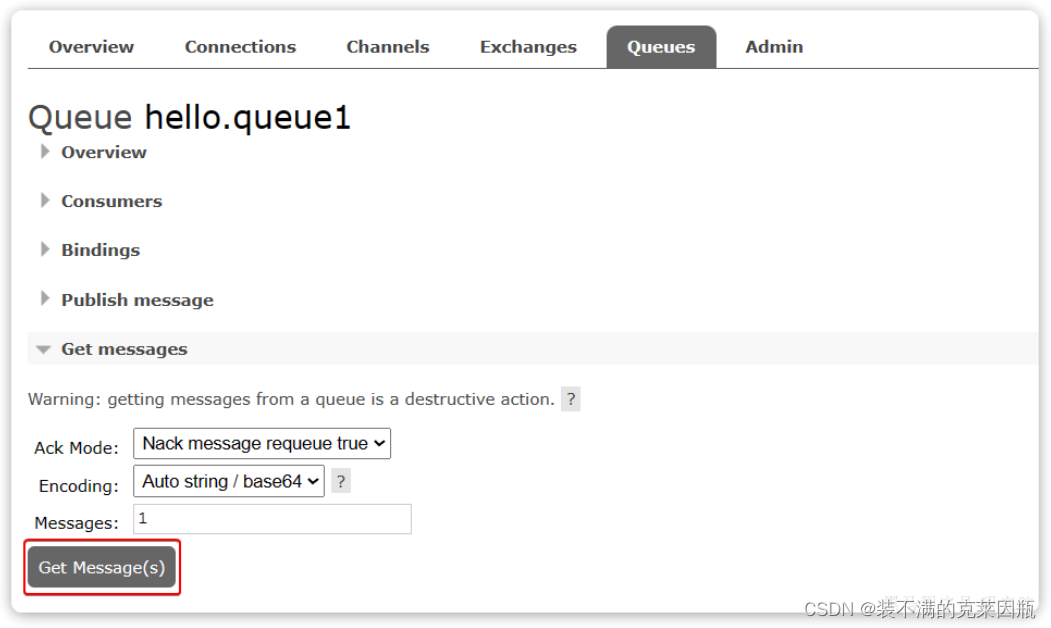
可以看到消息到达队列了:
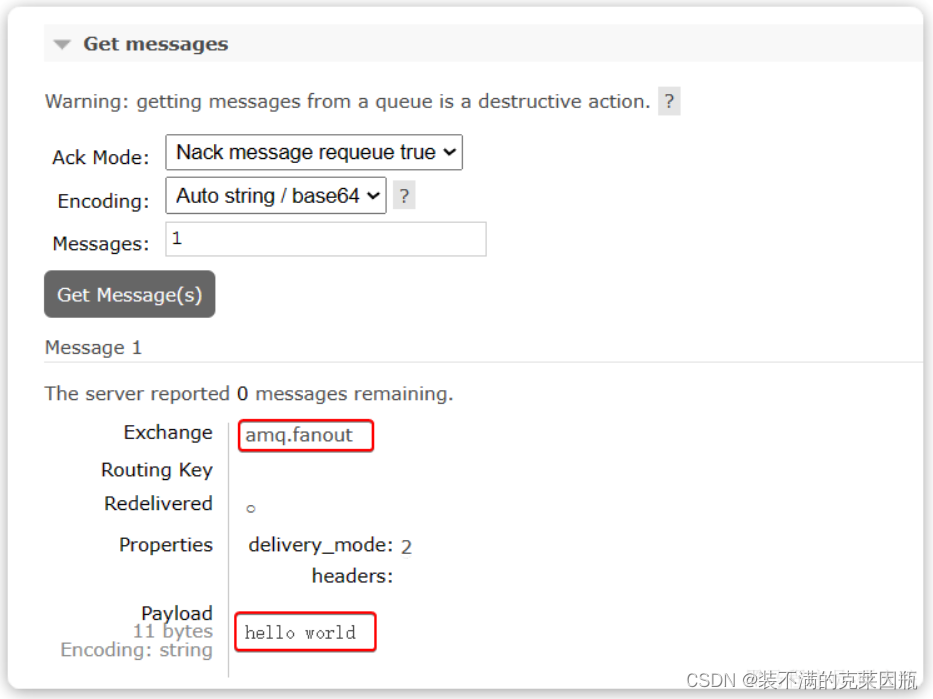
这个时候如果有消费者监听了MQ的hello.queue1或hello.queue2队列,自然就能接收到消息了。
2.3、数据隔离
2.3.1、用户管理
点击Admin选项卡,首先会看到RabbitMQ控制台的用户管理界面:
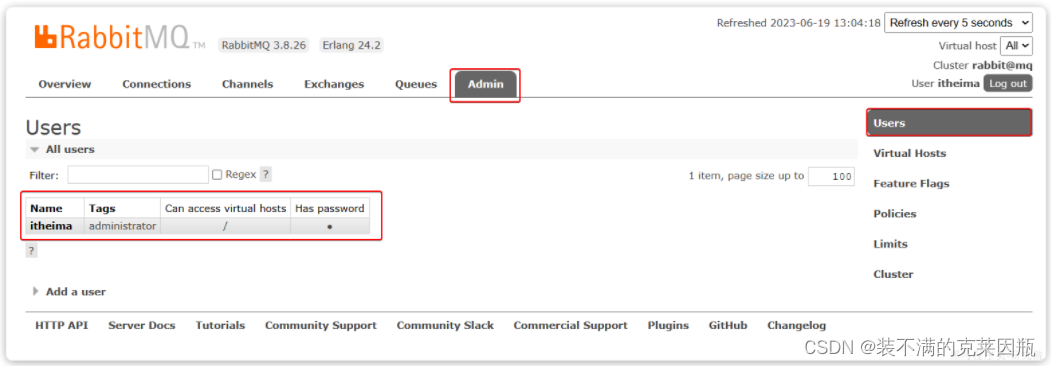
这里的用户都是RabbitMQ的管理或运维人员。目前只有安装RabbitMQ时添加的itheima这个用户。仔细观察用户表格中的字段,如下:
-
Name:itheima,也就是用户名 -
Tags:administrator,说明itheima用户是超级管理员,拥有所有权限 -
Can access virtual host:/,可以访问的virtual host,这里的/是默认的virtual host
对于小型企业而言,出于成本考虑,我们通常只会搭建一套MQ集群,公司内的多个不同项目同时使用。这个时候为了避免互相干扰, 我们会利用virtual host的隔离特性,将不同项目隔离。一般会做两件事情:
-
给每个项目创建独立的运维账号,将管理权限分离。
-
给每个项目创建不同的
virtual host,将每个项目的数据隔离。
比如,我们给黑马商城创建一个新的用户,命名为hmall:
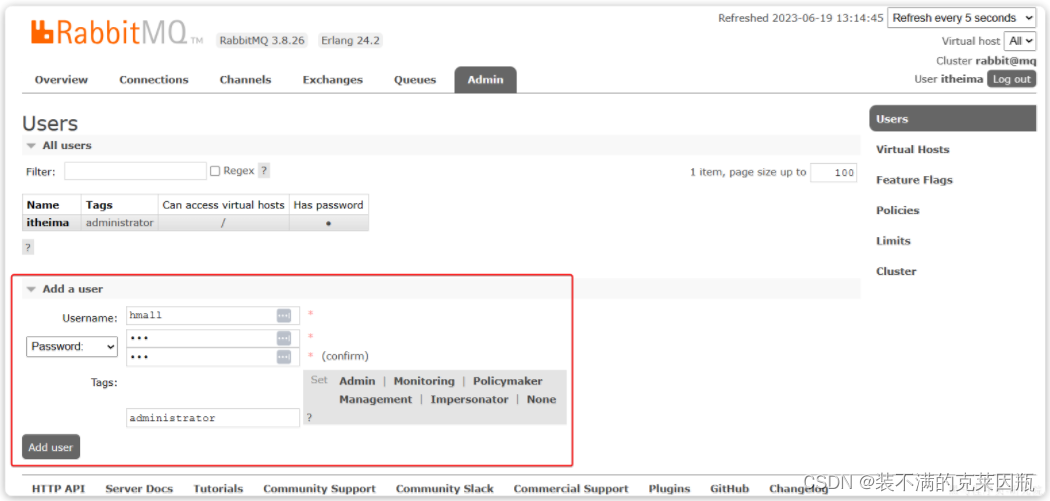
你会发现此时hmall用户没有任何virtual host的访问权限:

别急,接下来我们就来授权。
2.3.2、virtual host
我们先退出登录:

切换到刚刚创建的hmall用户登录,然后点击Virtual Hosts菜单,进入virtual host管理页:

可以看到目前只有一个默认的virtual host,名字为 /。
我们可以给黑马商城项目创建一个单独的virtual host,而不是使用默认的/。

创建完成后如图:

由于我们是登录hmall账户后创建的virtual host,因此回到users菜单,你会发现当前用户已经具备了对/hmall这个virtual host的访问权限了:
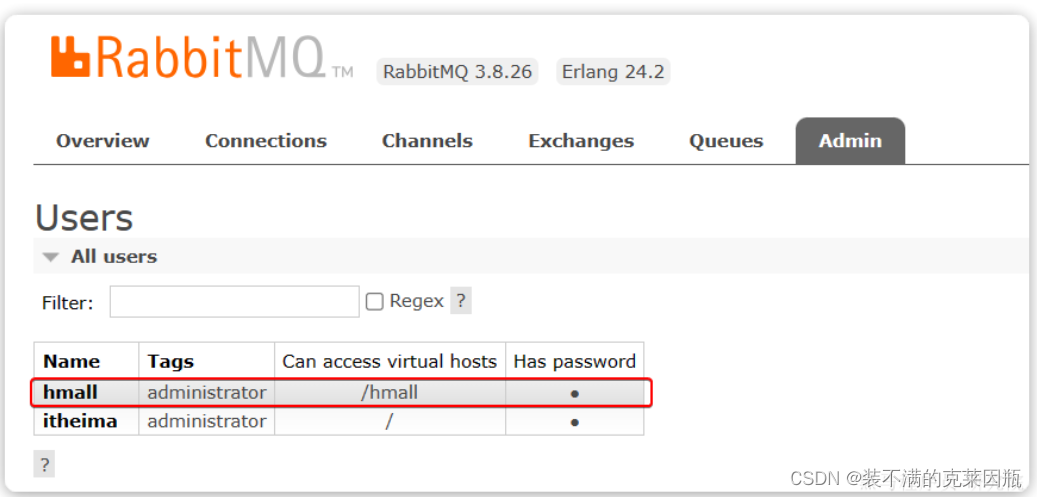
此时,点击页面右上角的virtual host下拉菜单,切换virtual host为 /hmall:

然后再次查看queues选项卡,会发现之前的队列已经看不到了:
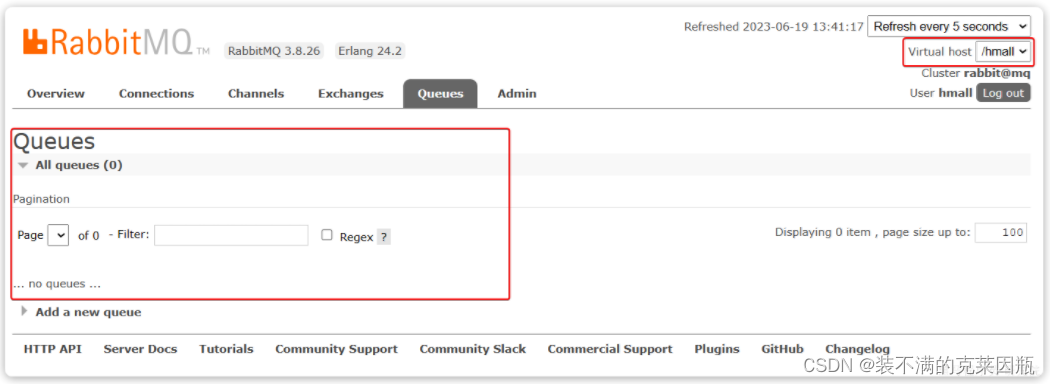
这就是基于virtual host的隔离效果。
三、SpringAMQP
将来我们开发业务功能的时候,肯定不会在控制台收发消息,而是应该基于编程的方式。由于RabbitMQ采用了AMQP协议,因此它具备跨语言的特性。任何语言只要遵循AMQP协议收发消息,都可以与RabbitMQ交互。并且RabbitMQ官方也提供了各种不同语言的客户端。但是,RabbitMQ官方提供的Java客户端编码相对复杂,一般生产环境下我们更多会结合Spring来使用。而Spring的官方刚好基于RabbitMQ提供了这样一套消息收发的模板工具:SpringAMQP。并且还基于SpringBoot对其实现了自动装配,使用起来非常方便。
SpringAmqp的官方地址:Spring AMQPSpringAMQP提供了三个功能:
-
自动声明队列、交换机及其绑定关系
-
基于注解的监听器模式,异步接收消息
-
封装了RabbitTemplate工具,用于发送消息
这一章我们就一起学习一下,如何利用SpringAMQP实现对RabbitMQ的消息收发。
3.1、导入Demo工程
在课前资料给大家提供了一个Demo工程,方便我们学习SpringAMQP的使用:

将其复制到你的工作空间,然后用Idea打开,项目结构如图:

包括三部分:
-
mq-demo:父工程,管理项目依赖
-
publisher:消息的发送者
-
consumer:消息的消费者
在mq-demo这个父工程中,已经配置好了SpringAMQP相关的依赖:
<?xml version="1.0" encoding="UTF-8"?>
<project xmlns="http://maven.apache.org/POM/4.0.0"
xmlns:xsi="http://www.w3.org/2001/XMLSchema-instance"
xsi:schemaLocation="http://maven.apache.org/POM/4.0.0 http://maven.apache.org/xsd/maven-4.0.0.xsd">
<modelVersion>4.0.0</modelVersion>
<groupId>cn.itcast.demo</groupId>
<artifactId>mq-demo</artifactId>
<version>1.0-SNAPSHOT</version>
<modules>
<module>publisher</module>
<module>consumer</module>
</modules>
<packaging>pom</packaging>
<parent>
<groupId>org.springframework.boot</groupId>
<artifactId>spring-boot-starter-parent</artifactId>
<version>2.7.12</version>
<relativePath/>
</parent>
<properties>
<maven.compiler.source>8</maven.compiler.source>
<maven.compiler.target>8</maven.compiler.target>
</properties>
<dependencies>
<dependency>
<groupId>org.projectlombok</groupId>
<artifactId>lombok</artifactId>
</dependency>
<!--AMQP依赖,包含RabbitMQ-->
<dependency>
<groupId>org.springframework.boot</groupId>
<artifactId>spring-boot-starter-amqp</artifactId>
</dependency>
<!--单元测试-->
<dependency>
<groupId>org.springframework.boot</groupId>
<artifactId>spring-boot-starter-test</artifactId>
</dependency>
</dependencies>
</project>因此,子工程中就可以直接使用SpringAMQP了。
3.2、快速入门
在之前的案例中,我们都是经过交换机发送消息到队列,不过有时候为了测试方便,我们也可以直接向队列发送消息,跳过交换机。
在入门案例中,我们就演示这样的简单模型,如图:

也就是:
-
publisher直接发送消息到队列
-
消费者监听并处理队列中的消息
注意:这种模式一般测试使用,很少在生产中使用。
为了方便测试,我们现在控制台新建一个队列:simple.queue

添加成功:
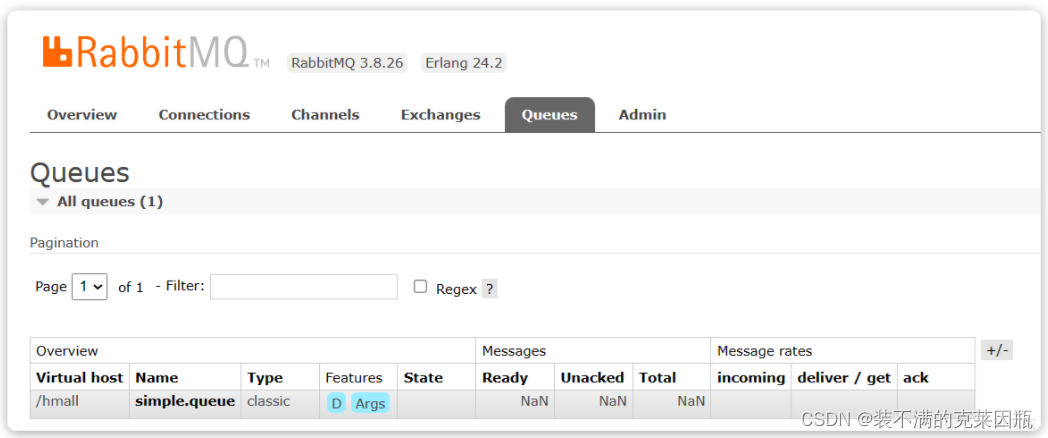
接下来,我们就可以利用Java代码收发消息了。
3.2.1、消息发送
首先配置MQ地址,在publisher服务的application.yml中添加配置:
spring:
rabbitmq:
host: 192.168.150.101 # 你的虚拟机IP
port: 5672 # 端口
virtual-host: /hmall # 虚拟主机
username: hmall # 用户名
password: 123 # 密码然后在publisher服务中编写测试类SpringAmqpTest,并利用RabbitTemplate实现消息发送:
package com.itheima.publisher.amqp;
import org.junit.jupiter.api.Test;
import org.springframework.amqp.rabbit.core.RabbitTemplate;
import org.springframework.beans.factory.annotation.Autowired;
import org.springframework.boot.test.context.SpringBootTest;
@SpringBootTest
public class SpringAmqpTest {
@Autowired
private RabbitTemplate rabbitTemplate;
@Test
public void testSimpleQueue() {
// 队列名称
String queueName = "simple.queue";
// 消息
String message = "hello, spring amqp!";
// 发送消息
rabbitTemplate.convertAndSend(queueName, message);
}
}打开控制台,可以看到消息已经发送到队列中:

接下来,我们再来实现消息接收。
3.2.2、消息接收
首先配置MQ地址,在consumer服务的application.yml中添加配置:
spring:
rabbitmq:
host: 192.168.150.101 # 你的虚拟机IP
port: 5672 # 端口
virtual-host: /hmall # 虚拟主机
username: hmall # 用户名
password: 123 # 密码然后在consumer服务的com.itheima.consumer.listener包中新建一个类SpringRabbitListener,代码如下:
package com.itheima.consumer.listener;
import org.springframework.amqp.rabbit.annotation.RabbitListener;
import org.springframework.stereotype.Component;
@Component
public class SpringRabbitListener {
// 利用RabbitListener来声明要监听的队列信息
// 将来一旦监听的队列中有了消息,就会推送给当前服务,调用当前方法,处理消息。
// 可以看到方法体中接收的就是消息体的内容
@RabbitListener(queues = "simple.queue")
public void listenSimpleQueueMessage(String msg) throws InterruptedException {
System.out.println("spring 消费者接收到消息:【" + msg + "】");
}
}3.2.3、测试
启动consumer服务,然后在publisher服务中运行测试代码,发送MQ消息。最终consumer收到消息:

3.3、WorkQueues模型
Work queues,任务模型。简单来说就是让多个消费者绑定到一个队列,共同消费队列中的消息。

当消息处理比较耗时的时候,可能生产消息的速度会远远大于消息的消费速度。长此以往,消息就会堆积越来越多,无法及时处理。此时就可以使用work 模型,多个消费者共同处理消息处理,消息处理的速度就能大大提高了。
接下来,我们就来模拟这样的场景。首先,我们在控制台创建一个新的队列,命名为work.queue:

3.3.1、消息发送
这次我们循环发送,模拟大量消息堆积现象。
在publisher服务中的SpringAmqpTest类中添加一个测试方法:
/**
* workQueue
* 向队列中不停发送消息,模拟消息堆积。
*/
@Test
public void testWorkQueue() throws InterruptedException {
// 队列名称
String queueName = "simple.queue";
// 消息
String message = "hello, message_";
for (int i = 0; i < 50; i++) {
// 发送消息,每20毫秒发送一次,相当于每秒发送50条消息
rabbitTemplate.convertAndSend(queueName, message + i);
Thread.sleep(20);
}
}3.3.2、消息接收
要模拟多个消费者绑定同一个队列,我们在consumer服务的SpringRabbitListener中添加2个新的方法:
@RabbitListener(queues = "work.queue")
public void listenWorkQueue1(String msg) throws InterruptedException {
System.out.println("消费者1接收到消息:【" + msg + "】" + LocalTime.now());
Thread.sleep(20);
}
@RabbitListener(queues = "work.queue")
public void listenWorkQueue2(String msg) throws InterruptedException {
System.err.println("消费者2........接收到消息:【" + msg + "】" + LocalTime.now());
Thread.sleep(200);
}注意到这两消费者,都设置了Thead.sleep,模拟任务耗时:
-
消费者1 sleep了20毫秒,相当于每秒钟处理50个消息
-
消费者2 sleep了200毫秒,相当于每秒处理5个消息
3.3.3、测试
启动ConsumerApplication后,在执行publisher服务中刚刚编写的发送测试方法testWorkQueue。最终结果如下:
消费者1接收到消息:【hello, message_0】21:06:00.869555300
消费者2........接收到消息:【hello, message_1】21:06:00.884518
消费者1接收到消息:【hello, message_2】21:06:00.907454400
消费者1接收到消息:【hello, message_4】21:06:00.953332100
消费者1接收到消息:【hello, message_6】21:06:00.997867300
消费者1接收到消息:【hello, message_8】21:06:01.042178700
消费者2........接收到消息:【hello, message_3】21:06:01.086478800
消费者1接收到消息:【hello, message_10】21:06:01.087476600
消费者1接收到消息:【hello, message_12】21:06:01.132578300
消费者1接收到消息:【hello, message_14】21:06:01.175851200
消费者1接收到消息:【hello, message_16】21:06:01.218533400
消费者1接收到消息:【hello, message_18】21:06:01.261322900
消费者2........接收到消息:【hello, message_5】21:06:01.287003700
消费者1接收到消息:【hello, message_20】21:06:01.304412400
消费者1接收到消息:【hello, message_22】21:06:01.349950100
消费者1接收到消息:【hello, message_24】21:06:01.394533900
消费者1接收到消息:【hello, message_26】21:06:01.439876500
消费者1接收到消息:【hello, message_28】21:06:01.482937800
消费者2........接收到消息:【hello, message_7】21:06:01.488977100
消费者1接收到消息:【hello, message_30】21:06:01.526409300
消费者1接收到消息:【hello, message_32】21:06:01.572148
消费者1接收到消息:【hello, message_34】21:06:01.618264800
消费者1接收到消息:【hello, message_36】21:06:01.660780600
消费者2........接收到消息:【hello, message_9】21:06:01.689189300
消费者1接收到消息:【hello, message_38】21:06:01.705261
消费者1接收到消息:【hello, message_40】21:06:01.746927300
消费者1接收到消息:【hello, message_42】21:06:01.789835
消费者1接收到消息:【hello, message_44】21:06:01.834393100
消费者1接收到消息:【hello, message_46】21:06:01.875312100
消费者2........接收到消息:【hello, message_11】21:06:01.889969500
消费者1接收到消息:【hello, message_48】21:06:01.920702500
消费者2........接收到消息:【hello, message_13】21:06:02.090725900
消费者2........接收到消息:【hello, message_15】21:06:02.293060600
消费者2........接收到消息:【hello, message_17】21:06:02.493748
消费者2........接收到消息:【hello, message_19】21:06:02.696635100
消费者2........接收到消息:【hello, message_21】21:06:02.896809700
消费者2........接收到消息:【hello, message_23】21:06:03.099533400
消费者2........接收到消息:【hello, message_25】21:06:03.301446400
消费者2........接收到消息:【hello, message_27】21:06:03.504999100
消费者2........接收到消息:【hello, message_29】21:06:03.705702500
消费者2........接收到消息:【hello, message_31】21:06:03.906601200
消费者2........接收到消息:【hello, message_33】21:06:04.108118500
消费者2........接收到消息:【hello, message_35】21:06:04.308945400
消费者2........接收到消息:【hello, message_37】21:06:04.511547700
消费者2........接收到消息:【hello, message_39】21:06:04.714038400
消费者2........接收到消息:【hello, message_41】21:06:04.916192700
消费者2........接收到消息:【hello, message_43】21:06:05.116286400
消费者2........接收到消息:【hello, message_45】21:06:05.318055100
消费者2........接收到消息:【hello, message_47】21:06:05.520656400
消费者2........接收到消息:【hello, message_49】21:06:05.723106700
也就是说消息是平均分配给每个消费者,并没有考虑到消费者的处理能力。导致1个消费者空闲,另一个消费者忙的不可开交。没有充分利用每一个消费者的能力,最终消息处理的耗时远远超过了1秒。这样显然是有问题的。
3.3.4、能者多劳
在spring中有一个简单的配置,可以解决这个问题。我们修改consumer服务的application.yml文件,添加配置:
spring:
rabbitmq:
listener:
simple:
prefetch: 1 # 每次只能获取一条消息,处理完成才能获取下一个消息再次测试,发现结果如下:
消费者1接收到消息:【hello, message_0】21:12:51.659664200
消费者2........接收到消息:【hello, message_1】21:12:51.680610
消费者1接收到消息:【hello, message_2】21:12:51.703625
消费者1接收到消息:【hello, message_3】21:12:51.724330100
消费者1接收到消息:【hello, message_4】21:12:51.746651100
消费者1接收到消息:【hello, message_5】21:12:51.768401400
消费者1接收到消息:【hello, message_6】21:12:51.790511400
消费者1接收到消息:【hello, message_7】21:12:51.812559800
消费者1接收到消息:【hello, message_8】21:12:51.834500600
消费者1接收到消息:【hello, message_9】21:12:51.857438800
消费者1接收到消息:【hello, message_10】21:12:51.880379600
消费者2........接收到消息:【hello, message_11】21:12:51.899327100
消费者1接收到消息:【hello, message_12】21:12:51.922828400
消费者1接收到消息:【hello, message_13】21:12:51.945617400
消费者1接收到消息:【hello, message_14】21:12:51.968942500
消费者1接收到消息:【hello, message_15】21:12:51.992215400
消费者1接收到消息:【hello, message_16】21:12:52.013325600
消费者1接收到消息:【hello, message_17】21:12:52.035687100
消费者1接收到消息:【hello, message_18】21:12:52.058188
消费者1接收到消息:【hello, message_19】21:12:52.081208400
消费者2........接收到消息:【hello, message_20】21:12:52.103406200
消费者1接收到消息:【hello, message_21】21:12:52.123827300
消费者1接收到消息:【hello, message_22】21:12:52.146165100
消费者1接收到消息:【hello, message_23】21:12:52.168828300
消费者1接收到消息:【hello, message_24】21:12:52.191769500
消费者1接收到消息:【hello, message_25】21:12:52.214839100
消费者1接收到消息:【hello, message_26】21:12:52.238998700
消费者1接收到消息:【hello, message_27】21:12:52.259772600
消费者1接收到消息:【hello, message_28】21:12:52.284131800
消费者2........接收到消息:【hello, message_29】21:12:52.306190600
消费者1接收到消息:【hello, message_30】21:12:52.325315800
消费者1接收到消息:【hello, message_31】21:12:52.347012500
消费者1接收到消息:【hello, message_32】21:12:52.368508600
消费者1接收到消息:【hello, message_33】21:12:52.391785100
消费者1接收到消息:【hello, message_34】21:12:52.416383800
消费者1接收到消息:【hello, message_35】21:12:52.439019
消费者1接收到消息:【hello, message_36】21:12:52.461733900
消费者1接收到消息:【hello, message_37】21:12:52.485990
消费者1接收到消息:【hello, message_38】21:12:52.509219900
消费者2........接收到消息:【hello, message_39】21:12:52.523683400
消费者1接收到消息:【hello, message_40】21:12:52.547412100
消费者1接收到消息:【hello, message_41】21:12:52.571191800
消费者1接收到消息:【hello, message_42】21:12:52.593024600
消费者1接收到消息:【hello, message_43】21:12:52.616731800
消费者1接收到消息:【hello, message_44】21:12:52.640317
消费者1接收到消息:【hello, message_45】21:12:52.663111100
消费者1接收到消息:【hello, message_46】21:12:52.686727
消费者1接收到消息:【hello, message_47】21:12:52.709266500
消费者2........接收到消息:【hello, message_48】21:12:52.725884900
消费者1接收到消息:【hello, message_49】21:12:52.746299900
可以发现,由于消费者1处理速度较快,所以处理了更多的消息;消费者2处理速度较慢,只处理了6条消息。而最终总的执行耗时也在1秒左右,大大提升。
正所谓能者多劳,这样充分利用了每一个消费者的处理能力,可以有效避免消息积压问题。
3.3.5、总结
Work模型的使用:
-
多个消费者绑定到一个队列,同一条消息只会被一个消费者处理
-
通过设置prefetch来控制消费者预取的消息数量
3.4、交换机类型
在之前的两个测试案例中,都没有交换机,生产者直接发送消息到队列。而一旦引入交换机,消息发送的模式会有很大变化:
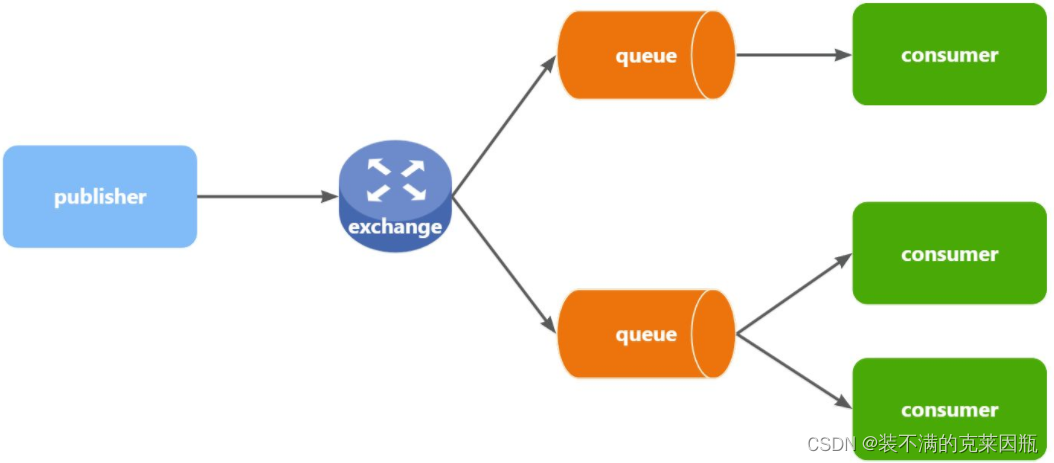
可以看到,在订阅模型中,多了一个exchange角色,而且过程略有变化:
-
Publisher:生产者,不再发送消息到队列中,而是发给交换机
-
Exchange:交换机,一方面,接收生产者发送的消息。另一方面,知道如何处理消息,例如递交给某个特别队列、递交给所有队列、或是将消息丢弃。到底如何操作,取决于Exchange的类型。
-
Queue:消息队列也与以前一样,接收消息、缓存消息。不过队列一定要与交换机绑定。
-
Consumer:消费者,与以前一样,订阅队列,没有变化
Exchange(交换机)只负责转发消息,不具备存储消息的能力,因此如果没有任何队列与Exchange绑定,或者没有符合路由规则的队列,那么消息会丢失!
交换机的类型有四种:
-
Fanout:广播,将消息交给所有绑定到交换机的队列。我们最早在控制台使用的正是Fanout交换机
-
Direct:订阅,基于RoutingKey(路由key)发送给订阅了消息的队列
-
Topic:通配符订阅,与Direct类似,只不过RoutingKey可以使用通配符
-
Headers:头匹配,基于MQ的消息头匹配,用的较少。
课堂中,我们讲解前面的三种交换机模式。
3.5、Fanout交换机
Fanout,英文翻译是扇出,我觉得在MQ中叫广播更合适。在广播模式下,消息发送流程是这样的:

-
1) 可以有多个队列
-
2) 每个队列都要绑定到Exchange(交换机)
-
3) 生产者发送的消息,只能发送到交换机
-
4) 交换机把消息发送给绑定过的所有队列
-
5) 订阅队列的消费者都能拿到消息
我们的计划是这样的:

-
创建一个名为
hmall.fanout的交换机,类型是Fanout -
创建两个队列
fanout.queue1和fanout.queue2,绑定到交换机hmall.fanout
3.5.1、声明队列和交换机
在控制台创建队列fanout.queue1:
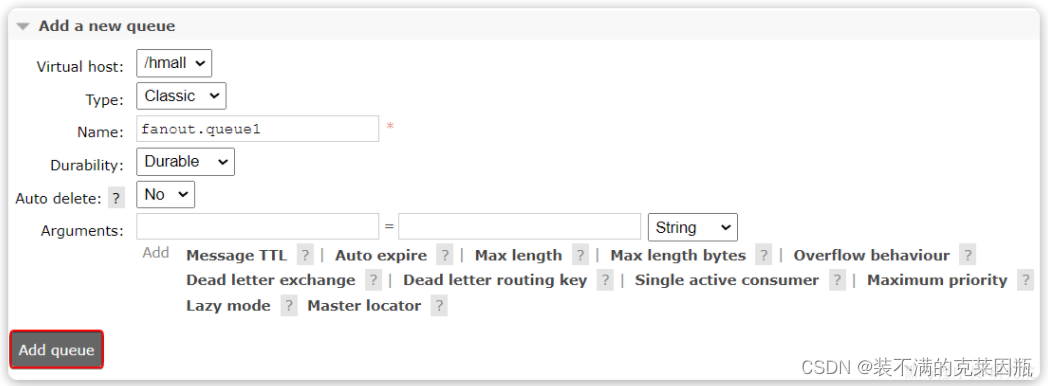
在创建一个队列fanout.queue2:

然后再创建一个交换机:

然后绑定两个队列到交换机:

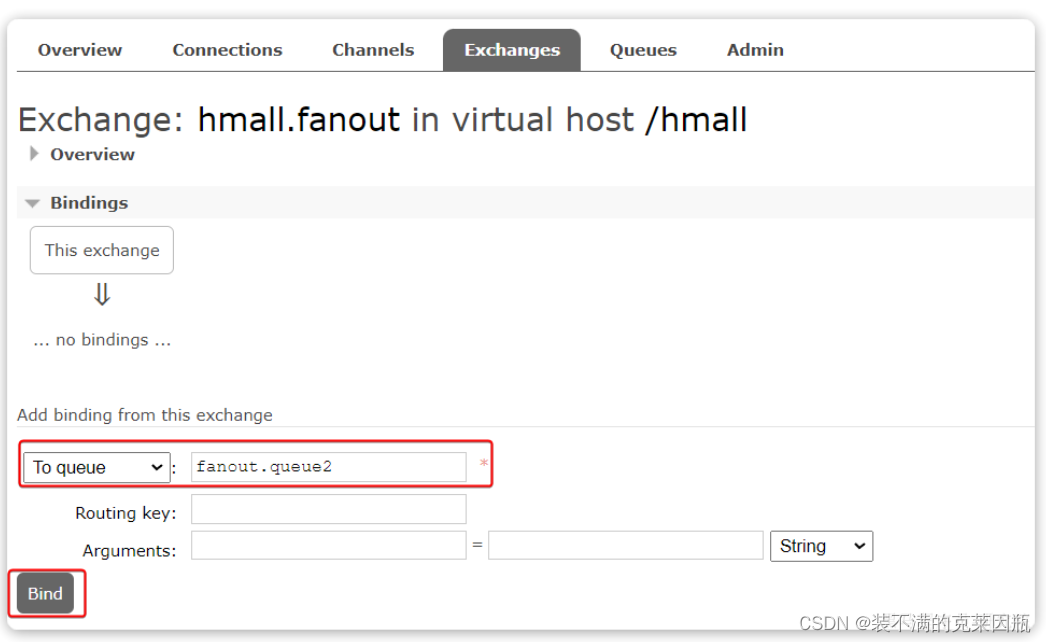
3.5.2、消息发送
在publisher服务的SpringAmqpTest类中添加测试方法:
@Test
public void testFanoutExchange() {
// 交换机名称
String exchangeName = "hmall.fanout";
// 消息
String message = "hello, everyone!";
rabbitTemplate.convertAndSend(exchangeName, "", message);
}3.5.3、消息接收
在consumer服务的SpringRabbitListener中添加两个方法,作为消费者:
@RabbitListener(queues = "fanout.queue1")
public void listenFanoutQueue1(String msg) {
System.out.println("消费者1接收到Fanout消息:【" + msg + "】");
}
@RabbitListener(queues = "fanout.queue2")
public void listenFanoutQueue2(String msg) {
System.out.println("消费者2接收到Fanout消息:【" + msg + "】");
}3.5.4、总结
交换机的作用是什么?
-
接收publisher发送的消息
-
将消息按照规则路由到与之绑定的队列
-
不能缓存消息,路由失败,消息丢失
-
FanoutExchange的会将消息路由到每个绑定的队列
3.6、Direct交换机
在Fanout模式中,一条消息,会被所有订阅的队列都消费。但是,在某些场景下,我们希望不同的消息被不同的队列消费。这时就要用到Direct类型的Exchange。

在Direct模型下:
-
队列与交换机的绑定,不能是任意绑定了,而是要指定一个
RoutingKey(路由key) -
消息的发送方在 向 Exchange发送消息时,也必须指定消息的
RoutingKey。 -
Exchange不再把消息交给每一个绑定的队列,而是根据消息的
Routing Key进行判断,只有队列的Routingkey与消息的Routing key完全一致,才会接收到消息
案例需求如图:
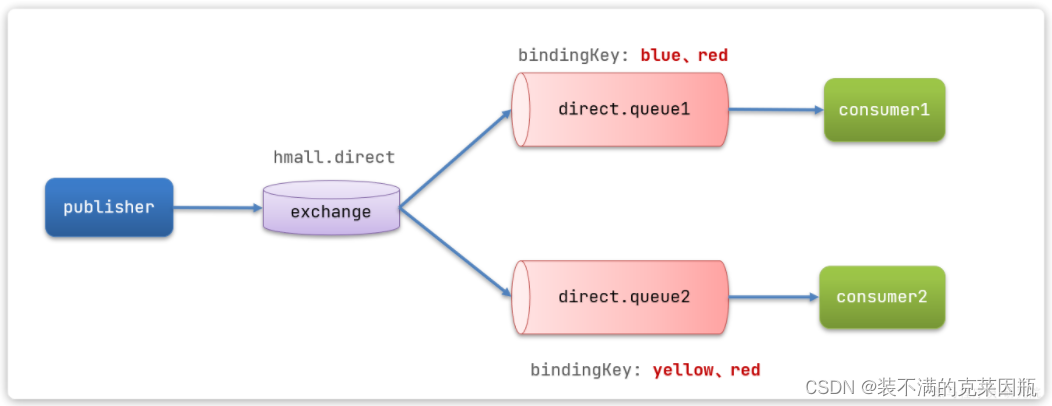
-
声明一个名为
hmall.direct的交换机 -
声明队列
direct.queue1,绑定hmall.direct,bindingKey为blud和red -
声明队列
direct.queue2,绑定hmall.direct,bindingKey为yellow和red -
在
consumer服务中,编写两个消费者方法,分别监听direct.queue1和direct.queue2 -
在publisher中编写测试方法,向
hmall.direct发送消息
3.6.1、声明队列和交换机
首先在控制台声明两个队列direct.queue1和direct.queue2,这里不再展示过程:
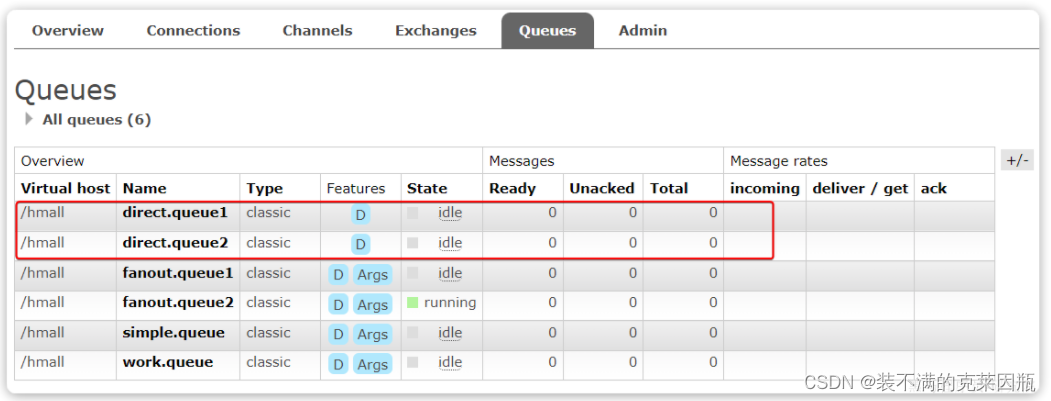
然后声明一个direct类型的交换机,命名为hmall.direct:

然后使用red和blue作为key,绑定direct.queue1到hmall.direct:
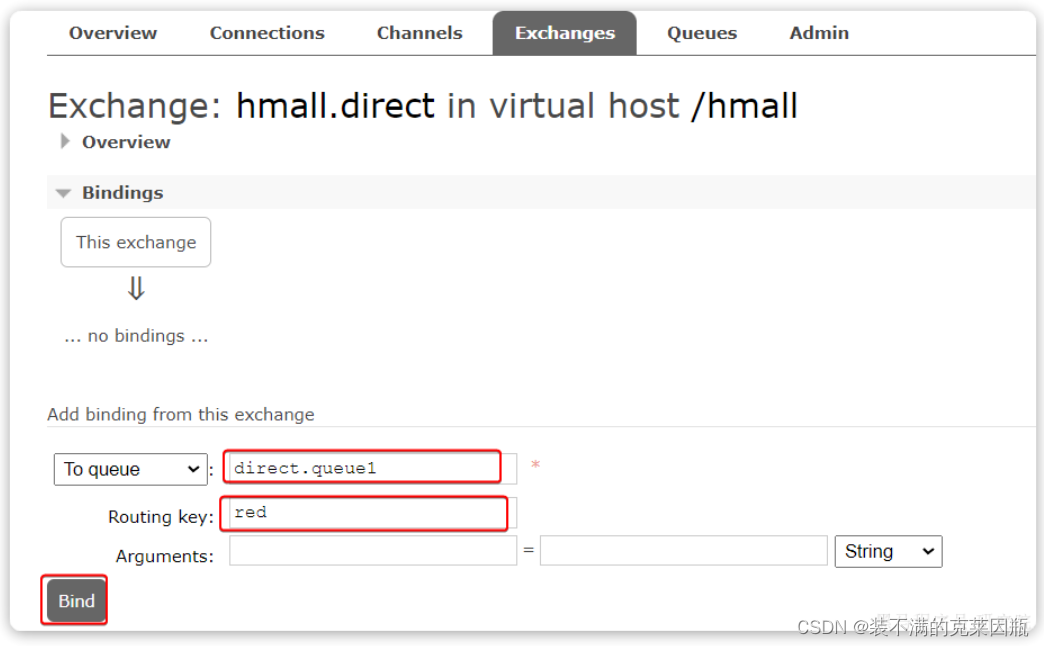
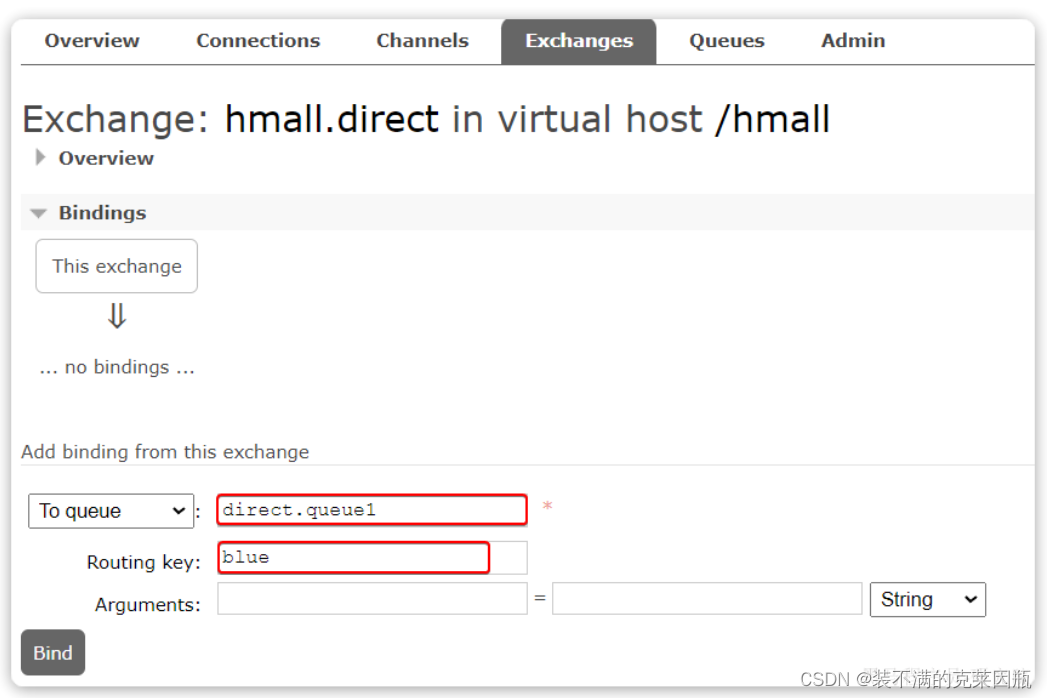
同理,使用red和yellow作为key,绑定direct.queue2到hmall.direct,步骤略,最终结果:
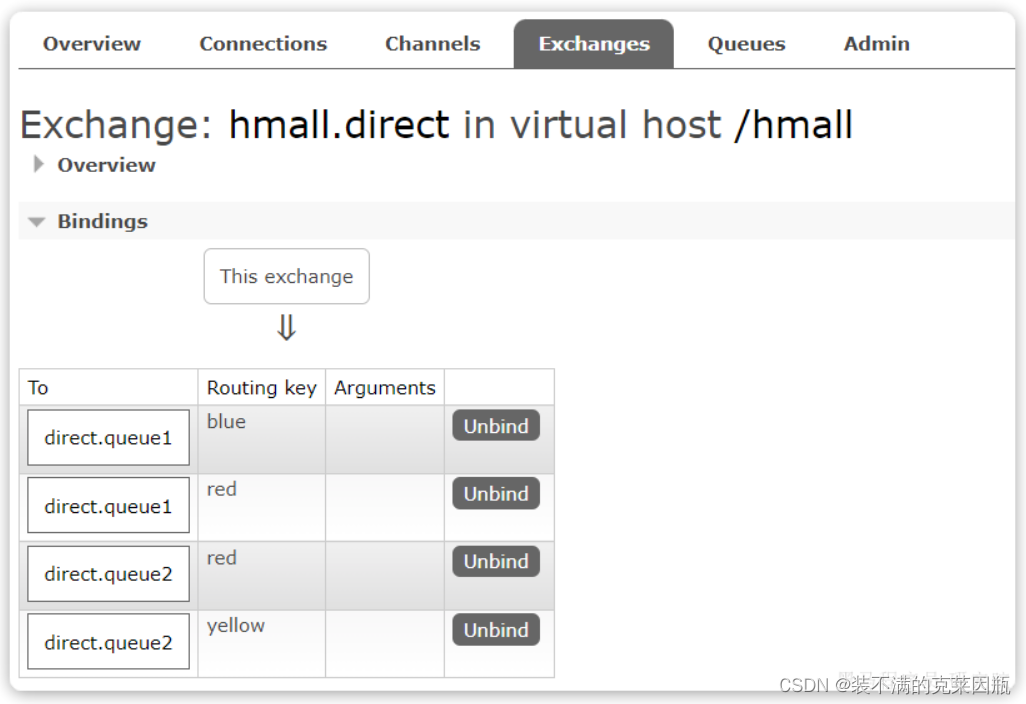
3.6.2、消息接收
在consumer服务的SpringRabbitListener中添加方法:
@RabbitListener(queues = "direct.queue1")
public void listenDirectQueue1(String msg) {
System.out.println("消费者1接收到direct.queue1的消息:【" + msg + "】");
}
@RabbitListener(queues = "direct.queue2")
public void listenDirectQueue2(String msg) {
System.out.println("消费者2接收到direct.queue2的消息:【" + msg + "】");
}3.6.3、消息发送
在publisher服务的SpringAmqpTest类中添加测试方法:
@Test
public void testSendDirectExchange() {
// 交换机名称
String exchangeName = "hmall.direct";
// 消息
String message = "红色警报!日本乱排核废水,导致海洋生物变异,惊现哥斯拉!";
// 发送消息
rabbitTemplate.convertAndSend(exchangeName, "red", message);
}由于使用的red这个key,所以两个消费者都收到了消息:

我们再切换为blue这个key:
@Test
public void testSendDirectExchange() {
// 交换机名称
String exchangeName = "hmall.direct";
// 消息
String message = "最新报道,哥斯拉是居民自治巨型气球,虚惊一场!";
// 发送消息
rabbitTemplate.convertAndSend(exchangeName, "blue", message);
}你会发现,只有消费者1收到了消息:

3.6.4、总结
描述下Direct交换机与Fanout交换机的差异?
-
Fanout交换机将消息路由给每一个与之绑定的队列
-
Direct交换机根据RoutingKey判断路由给哪个队列
-
如果多个队列具有相同的RoutingKey,则与Fanout功能类似
3.7、Topic交换机
3.7.1、说明
Topic类型的Exchange与Direct相比,都是可以根据RoutingKey把消息路由到不同的队列。只不过Topic类型Exchange可以让队列在绑定BindingKey 的时候使用通配符!
BindingKey 一般都是有一个或多个单词组成,多个单词之间以.分割,例如: item.insert
通配符规则:
-
#:匹配一个或多个词 -
*:匹配不多不少恰好1个词
举例:
-
item.#:能够匹配item.spu.insert或者item.spu -
item.*:只能匹配item.spu
图示:

假如此时publisher发送的消息使用的RoutingKey共有四种:
-
china.news代表有中国的新闻消息; -
china.weather代表中国的天气消息; -
japan.news则代表日本新闻 -
japan.weather代表日本的天气消息;
解释:
-
topic.queue1:绑定的是china.#,凡是以china.开头的routing key都会被匹配到,包括:-
china.news -
china.weather
-
-
topic.queue2:绑定的是#.news,凡是以.news结尾的routing key都会被匹配。包括:-
china.news -
japan.news
-
接下来,我们就按照上图所示,来演示一下Topic交换机的用法。首先,在控制台按照图示例子创建队列、交换机,并利用通配符绑定队列和交换机。此处步骤略。最终结果如下:
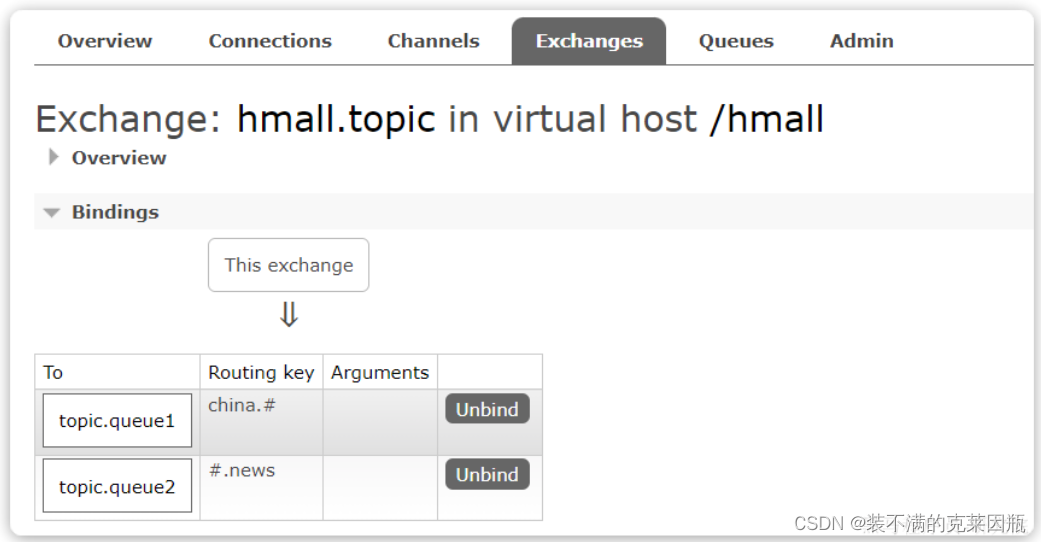
3.7.2、消息发送
在publisher服务的SpringAmqpTest类中添加测试方法:
/**
* topicExchange
*/
@Test
public void testSendTopicExchange() {
// 交换机名称
String exchangeName = "hmall.topic";
// 消息
String message = "喜报!孙悟空大战哥斯拉,胜!";
// 发送消息
rabbitTemplate.convertAndSend(exchangeName, "china.news", message);
}3.7.3、消息接收
在consumer服务的SpringRabbitListener中添加方法:
@RabbitListener(queues = "topic.queue1")
public void listenTopicQueue1(String msg){
System.out.println("消费者1接收到topic.queue1的消息:【" + msg + "】");
}
@RabbitListener(queues = "topic.queue2")
public void listenTopicQueue2(String msg){
System.out.println("消费者2接收到topic.queue2的消息:【" + msg + "】");
}3.7.4、总结
描述下Direct交换机与Topic交换机的差异?
-
Topic交换机接收的消息RoutingKey必须是多个单词,以
**.**分割 -
Topic交换机与队列绑定时的bindingKey可以指定通配符
-
#:代表0个或多个词 -
*:代表1个词
3.8、声明队列和交换机
在之前我们都是基于RabbitMQ控制台来创建队列、交换机。但是在实际开发时,队列和交换机是程序员定义的,将来项目上线,又要交给运维去创建。那么程序员就需要把程序中运行的所有队列和交换机都写下来,交给运维。在这个过程中是很容易出现错误的。因此推荐的做法是由程序启动时检查队列和交换机是否存在,如果不存在自动创建。
3.8.1、基本API
SpringAMQP提供了一个Queue类,用来创建队列:

SpringAMQP还提供了一个Exchange接口,来表示所有不同类型的交换机:

ExchangeBuilder来简化这个过程:
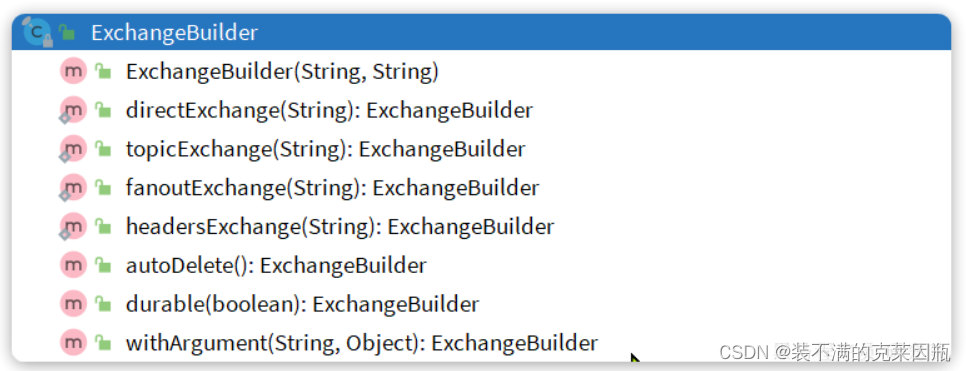
而在绑定队列和交换机时,则需要使用BindingBuilder来创建Binding对象:

3.8.2、fanout示例
在consumer中创建一个类,声明队列和交换机:
package com.itheima.consumer.config;
import org.springframework.amqp.core.Binding;
import org.springframework.amqp.core.BindingBuilder;
import org.springframework.amqp.core.FanoutExchange;
import org.springframework.amqp.core.Queue;
import org.springframework.context.annotation.Bean;
import org.springframework.context.annotation.Configuration;
@Configuration
public class FanoutConfig {
/**
* 声明交换机
* @return Fanout类型交换机
*/
@Bean
public FanoutExchange fanoutExchange(){
return new FanoutExchange("hmall.fanout");
}
/**
* 第1个队列
*/
@Bean
public Queue fanoutQueue1(){
return new Queue("fanout.queue1");
}
/**
* 绑定队列和交换机
*/
@Bean
public Binding bindingQueue1(Queue fanoutQueue1, FanoutExchange fanoutExchange){
return BindingBuilder.bind(fanoutQueue1).to(fanoutExchange);
}
/**
* 第2个队列
*/
@Bean
public Queue fanoutQueue2(){
return new Queue("fanout.queue2");
}
/**
* 绑定队列和交换机
*/
@Bean
public Binding bindingQueue2(Queue fanoutQueue2, FanoutExchange fanoutExchange){
return BindingBuilder.bind(fanoutQueue2).to(fanoutExchange);
}
}3.8.2、direct示例
direct模式由于要绑定多个KEY,会非常麻烦,每一个Key都要编写一个binding:
package com.itheima.consumer.config;
import org.springframework.amqp.core.*;
import org.springframework.context.annotation.Bean;
import org.springframework.context.annotation.Configuration;
@Configuration
public class DirectConfig {
/**
* 声明交换机
* @return Direct类型交换机
*/
@Bean
public DirectExchange directExchange(){
return ExchangeBuilder.directExchange("hmall.direct").build();
}
/**
* 第1个队列
*/
@Bean
public Queue directQueue1(){
return new Queue("direct.queue1");
}
/**
* 绑定队列和交换机
*/
@Bean
public Binding bindingQueue1WithRed(Queue directQueue1, DirectExchange directExchange){
return BindingBuilder.bind(directQueue1).to(directExchange).with("red");
}
/**
* 绑定队列和交换机
*/
@Bean
public Binding bindingQueue1WithBlue(Queue directQueue1, DirectExchange directExchange){
return BindingBuilder.bind(directQueue1).to(directExchange).with("blue");
}
/**
* 第2个队列
*/
@Bean
public Queue directQueue2(){
return new Queue("direct.queue2");
}
/**
* 绑定队列和交换机
*/
@Bean
public Binding bindingQueue2WithRed(Queue directQueue2, DirectExchange directExchange){
return BindingBuilder.bind(directQueue2).to(directExchange).with("red");
}
/**
* 绑定队列和交换机
*/
@Bean
public Binding bindingQueue2WithYellow(Queue directQueue2, DirectExchange directExchange){
return BindingBuilder.bind(directQueue2).to(directExchange).with("yellow");
}
}
3.8.4、基于注解声明
基于@Bean的方式声明队列和交换机比较麻烦,Spring还提供了基于注解方式来声明。
例如,我们同样声明Direct模式的交换机和队列:
@RabbitListener(bindings = @QueueBinding(
value = @Queue(name = "direct.queue1"),
exchange = @Exchange(name = "hmall.direct", type = ExchangeTypes.DIRECT),
key = {"red", "blue"}
))
public void listenDirectQueue1(String msg){
System.out.println("消费者1接收到direct.queue1的消息:【" + msg + "】");
}
@RabbitListener(bindings = @QueueBinding(
value = @Queue(name = "direct.queue2"),
exchange = @Exchange(name = "hmall.direct", type = ExchangeTypes.DIRECT),
key = {"red", "yellow"}
))
public void listenDirectQueue2(String msg){
System.out.println("消费者2接收到direct.queue2的消息:【" + msg + "】");
}是不是简单多了。
再试试Topic模式:
@RabbitListener(bindings = @QueueBinding(
value = @Queue(name = "topic.queue1"),
exchange = @Exchange(name = "hmall.topic", type = ExchangeTypes.TOPIC),
key = "china.#"
))
public void listenTopicQueue1(String msg){
System.out.println("消费者1接收到topic.queue1的消息:【" + msg + "】");
}
@RabbitListener(bindings = @QueueBinding(
value = @Queue(name = "topic.queue2"),
exchange = @Exchange(name = "hmall.topic", type = ExchangeTypes.TOPIC),
key = "#.news"
))
public void listenTopicQueue2(String msg){
System.out.println("消费者2接收到topic.queue2的消息:【" + msg + "】");
}3.9、消息转换器
Spring的消息发送代码接收的消息体是一个Object:

而在数据传输时,它会把你发送的消息序列化为字节发送给MQ,接收消息的时候,还会把字节反序列化为Java对象。只不过,默认情况下Spring采用的序列化方式是JDK序列化。众所周知,JDK序列化存在下列问题:
-
数据体积过大
-
有安全漏洞
-
可读性差
我们来测试一下。
3.9.1、测试默认转换器
1)创建测试队列
首先,我们在consumer服务中声明一个新的配置类:

利用@Bean的方式创建一个队列, 具体代码:
package com.itheima.consumer.config;
import org.springframework.amqp.core.Queue;
import org.springframework.context.annotation.Bean;
import org.springframework.context.annotation.Configuration;
@Configuration
public class MessageConfig {
@Bean
public Queue objectQueue() {
return new Queue("object.queue");
}
}注意,这里我们先不要给这个队列添加消费者,我们要查看消息体的格式。
重启consumer服务以后,该队列就会被自动创建出来了:

2)发送消息
我们在publisher模块的SpringAmqpTest中新增一个消息发送的代码,发送一个Map对象:
@Test
public void testSendMap() throws InterruptedException {
// 准备消息
Map<String,Object> msg = new HashMap<>();
msg.put("name", "柳岩");
msg.put("age", 21);
// 发送消息
rabbitTemplate.convertAndSend("object.queue", msg);
}发送消息后查看控制台:
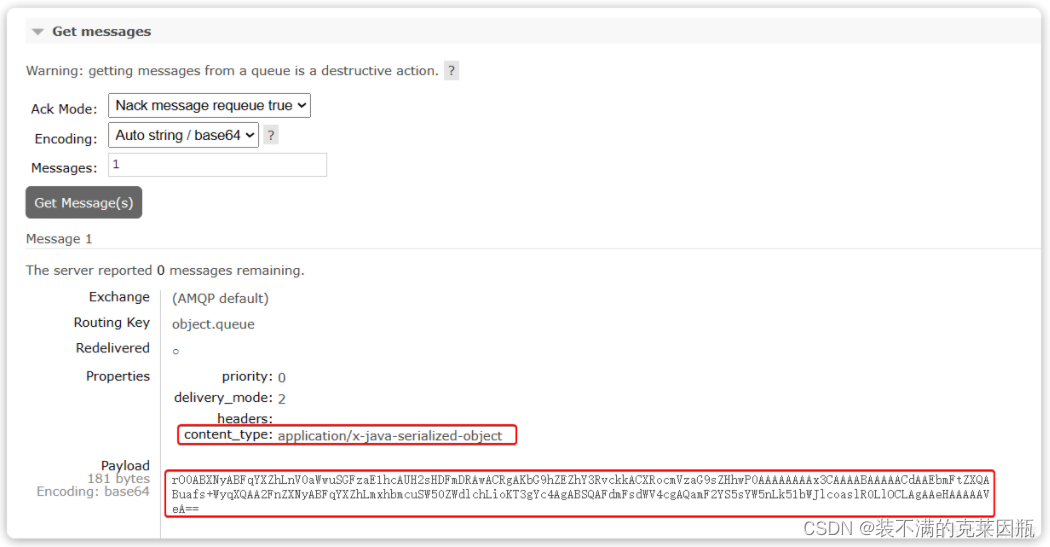
可以看到消息格式非常不友好。
3.9.2、配置JSON转换器
显然,JDK序列化方式并不合适。我们希望消息体的体积更小、可读性更高,因此可以使用JSON方式来做序列化和反序列化。
在publisher和consumer两个服务中都引入依赖:
<dependency>
<groupId>com.fasterxml.jackson.dataformat</groupId>
<artifactId>jackson-dataformat-xml</artifactId>
<version>2.9.10</version>
</dependency>注意,如果项目中引入了spring-boot-starter-web依赖,则无需再次引入Jackson依赖。
配置消息转换器,在publisher和consumer两个服务的启动类中添加一个Bean即可:
@Bean
public MessageConverter messageConverter(){
// 1.定义消息转换器
Jackson2JsonMessageConverter jackson2JsonMessageConverter = new Jackson2JsonMessageConverter();
// 2.配置自动创建消息id,用于识别不同消息,也可以在业务中基于ID判断是否是重复消息
jackson2JsonMessageConverter.setCreateMessageIds(true);
return jackson2JsonMessageConverter;
}消息转换器中添加的messageId可以便于我们将来做幂等性判断。
此时,我们到MQ控制台删除object.queue中的旧的消息。然后再次执行刚才的消息发送的代码,到MQ的控制台查看消息结构:
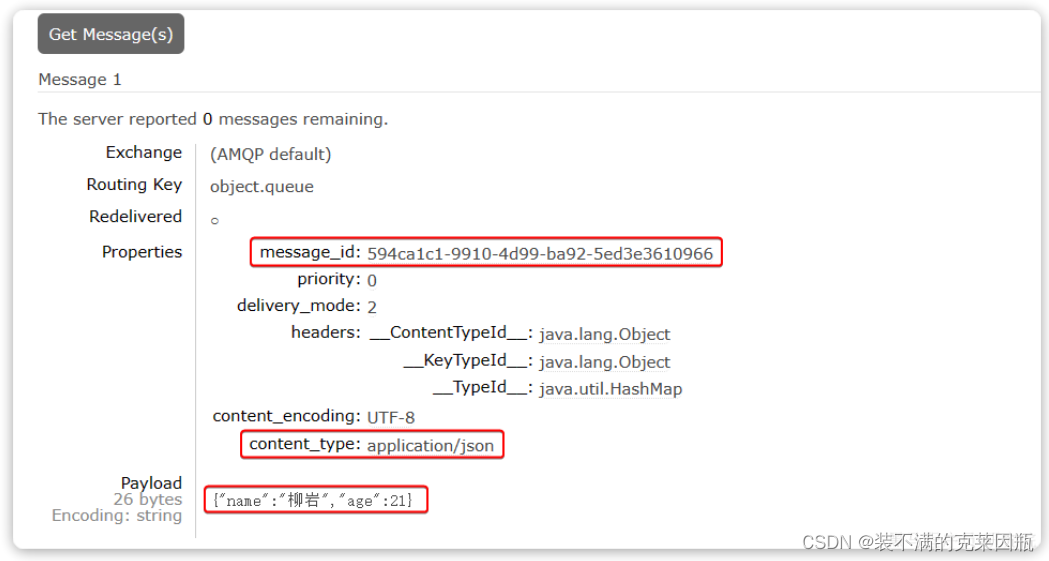
3.9.3、消费者接收Object
我们在consumer服务中定义一个新的消费者,publisher是用Map发送,那么消费者也一定要用Map接收,格式如下:
@RabbitListener(queues = "object.queue")
public void listenSimpleQueueMessage(Map<String, Object> msg) throws InterruptedException {
System.out.println("消费者接收到object.queue消息:【" + msg + "】");
}四、业务改造
案例需求:改造余额支付功能,将支付成功后基于OpenFeign的交易服务的更新订单状态接口的同步调用,改为基于RabbitMQ的异步通知。
如图:
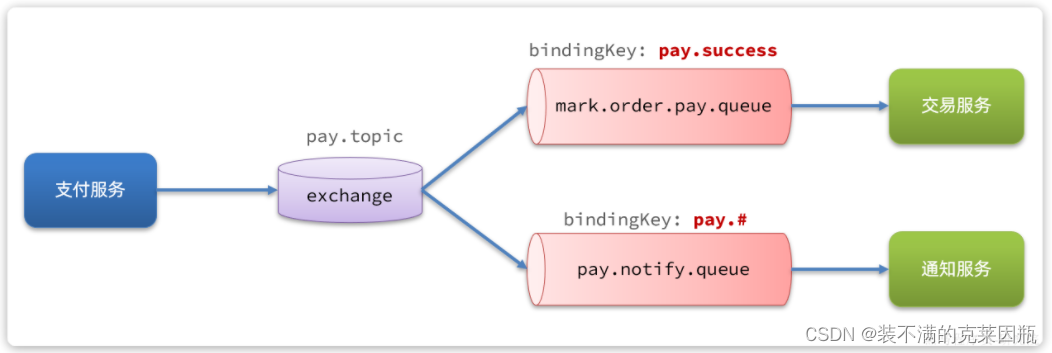
说明,我们只关注交易服务,步骤如下:
-
定义topic类型交换机,命名为
pay.topic -
定义消息队列,命名为
mark.order.pay.queue -
将
mark.order.pay.queue与pay.topic绑定,BindingKey为pay.success -
支付成功时不再调用交易服务更新订单状态的接口,而是发送一条消息到
pay.topic,发送消息的RoutingKey为pay.success,消息内容是订单id -
交易服务监听
mark.order.pay.queue队列,接收到消息后更新订单状态为已支付
4.1、配置MQ
不管是生产者还是消费者,都需要配置MQ的基本信息。分为两步:
1)添加依赖:
<!--消息发送-->
<dependency>
<groupId>org.springframework.boot</groupId>
<artifactId>spring-boot-starter-amqp</artifactId>
</dependency>2)配置MQ地址:
spring:
rabbitmq:
host: 192.168.150.101 # 你的虚拟机IP
port: 5672 # 端口
virtual-host: /hmall # 虚拟主机
username: hmall # 用户名
password: 123 # 密码4.1、接收消息
在trade-service服务中定义一个消息监听类:
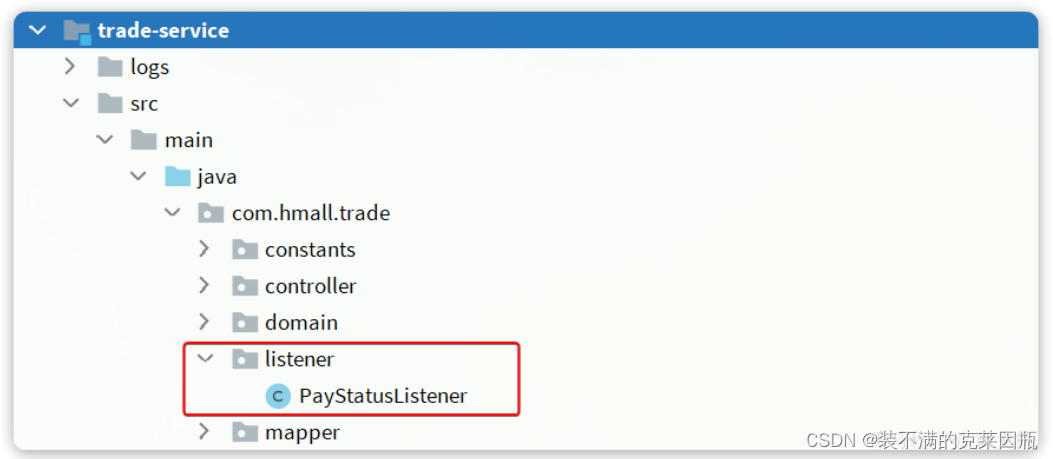
其代码如下:
package com.hmall.trade.listener;
import com.hmall.trade.service.IOrderService;
import lombok.RequiredArgsConstructor;
import org.springframework.amqp.core.ExchangeTypes;
import org.springframework.amqp.rabbit.annotation.Exchange;
import org.springframework.amqp.rabbit.annotation.Queue;
import org.springframework.amqp.rabbit.annotation.QueueBinding;
import org.springframework.amqp.rabbit.annotation.RabbitListener;
import org.springframework.stereotype.Component;
@Component
@RequiredArgsConstructor
public class PayStatusListener {
private final IOrderService orderService;
@RabbitListener(bindings = @QueueBinding(
value = @Queue(name = "mark.order.pay.queue", durable = "true"),
exchange = @Exchange(name = "pay.topic", type = ExchangeTypes.TOPIC),
key = "pay.success"
))
public void listenPaySuccess(Long orderId){
orderService.markOrderPaySuccess(orderId);
}
}4.2、发送消息
修改pay-service服务下的com.hmall.pay.service.impl.PayOrderServiceImpl类中的tryPayOrderByBalance方法:
private final RabbitTemplate rabbitTemplate;
@Override
@Transactional
public void tryPayOrderByBalance(PayOrderDTO payOrderDTO) {
// 1.查询支付单
PayOrder po = getById(payOrderDTO.getId());
// 2.判断状态
if(!PayStatus.WAIT_BUYER_PAY.equalsValue(po.getStatus())){
// 订单不是未支付,状态异常
throw new BizIllegalException("交易已支付或关闭!");
}
// 3.尝试扣减余额
userClient.deductMoney(payOrderDTO.getPw(), po.getAmount());
// 4.修改支付单状态
boolean success = markPayOrderSuccess(payOrderDTO.getId(), LocalDateTime.now());
if (!success) {
throw new BizIllegalException("交易已支付或关闭!");
}
// 5.修改订单状态
// tradeClient.markOrderPaySuccess(po.getBizOrderNo());
try {
rabbitTemplate.convertAndSend("pay.topic", "pay.success", po.getBizOrderNo());
} catch (Exception e) {
log.error("支付成功的消息发送失败,支付单id:{}, 交易单id:{}", po.getId(), po.getBizOrderNo(), e);
}
}























 7255
7255











 被折叠的 条评论
为什么被折叠?
被折叠的 条评论
为什么被折叠?










